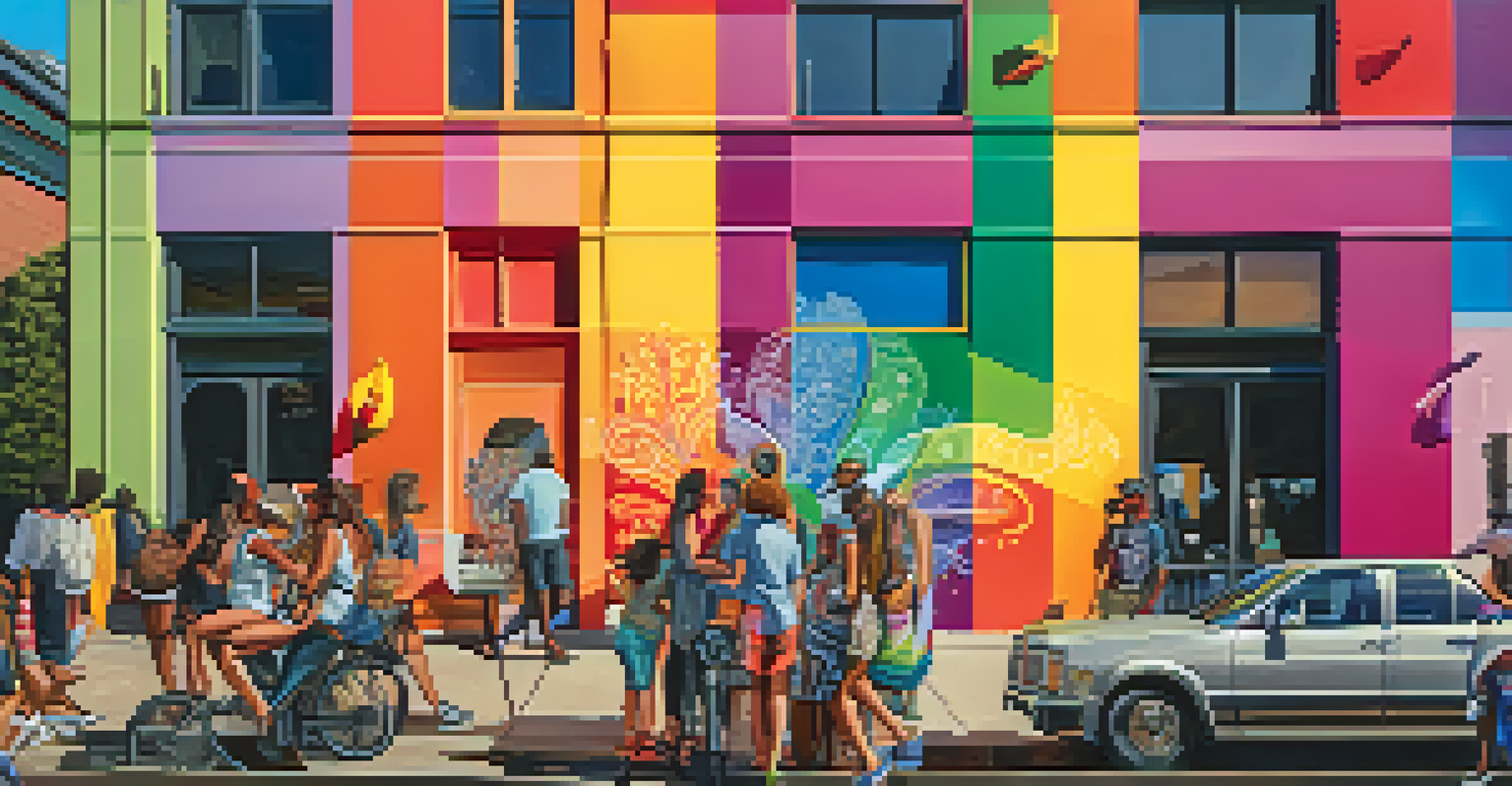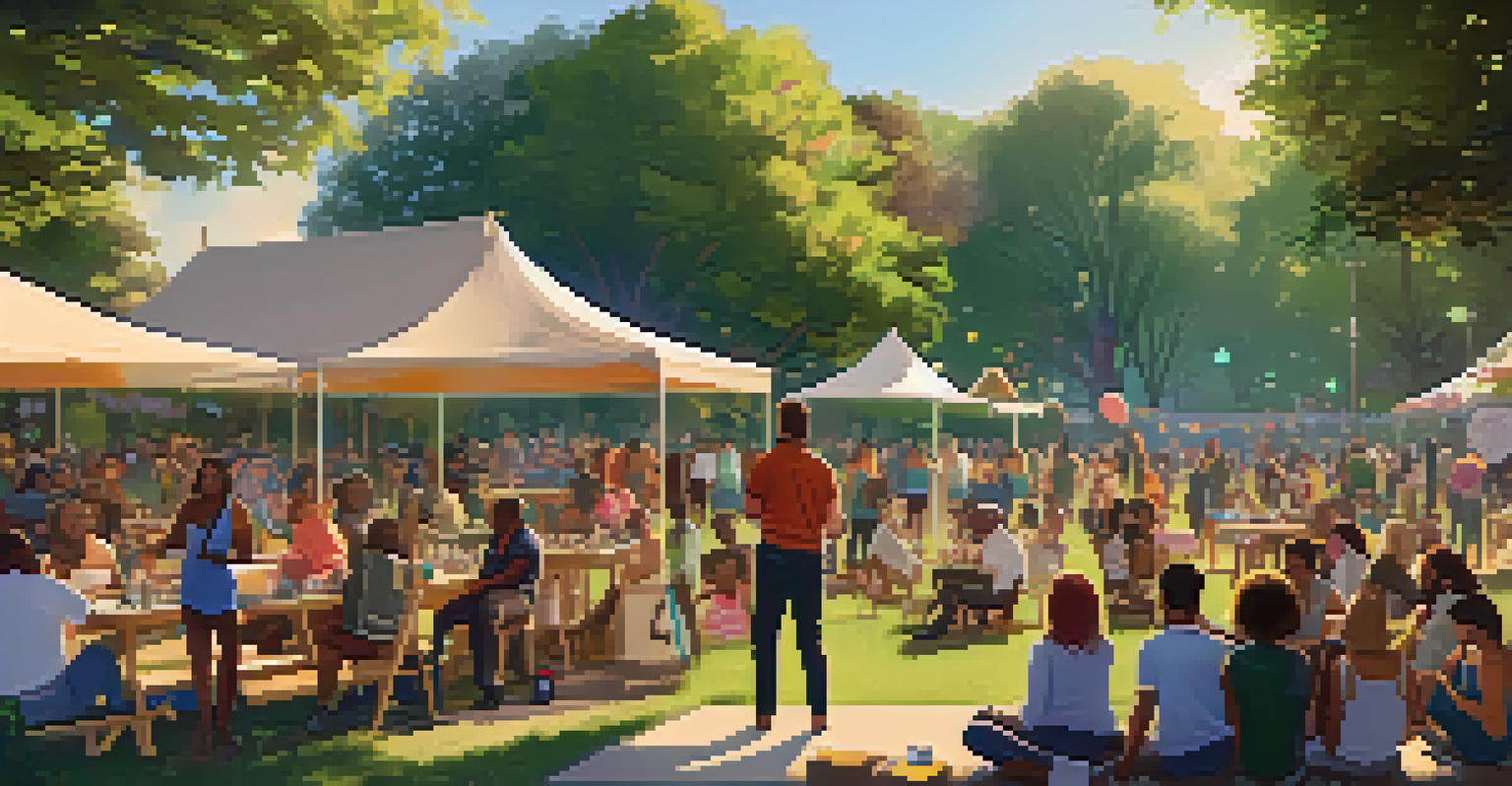A Historical Overview of Austin's LGBTQ+ Community Development

Early LGBTQ+ Presence in Austin: The Roots of Community
Austin's LGBTQ+ community has deep roots that trace back to the early 20th century. While the city was still growing, small groups of LGBTQ+ individuals began to form, often gathering in clandestine settings due to societal pressures. These early gatherings laid the groundwork for a community that would grow more visible and vocal over the decades.
The arc of the moral universe is long, but it bends toward justice.
In the 1950s and 60s, Austin was a bit of a hidden gem for LGBTQ+ individuals, attracting those seeking a more accepting environment. Despite the broader societal stigma, this era saw the establishment of informal networks and friendships, creating a sense of belonging among those who often felt isolated. It was during this time that the seeds of activism were planted in the hearts of many.
As the counterculture movement emerged in the late 1960s, Austin became a backdrop for LGBTQ+ visibility, with more individuals openly expressing their identities. The Stonewall Riots in 1969 ignited a fire across the nation, including in Austin, prompting many to take a stand for their rights and push for greater acceptance.
The Birth of Activism: 1970s and 1980s
The 1970s marked a significant turning point for Austin's LGBTQ+ community, as activism began to flourish. Organizations like the Austin Gay Alliance were founded, focusing on advocacy and support for local LGBTQ+ individuals. This period saw the first pride events, which transformed from mere gatherings into powerful demonstrations for equality and acceptance.

With the advent of the AIDS crisis in the 1980s, the community faced challenges that were both devastating and galvanizing. Activism intensified as individuals rallied to support those affected by the disease and to demand governmental action. This period of hardship also fostered a strong sense of solidarity within the community, bringing people together to fight for their rights.
Historic Roots of Austin's LGBTQ+ Community
Austin's LGBTQ+ community has a rich history that began in the early 20th century, evolving from clandestine gatherings to a vibrant and vocal presence.
The 1980s also witnessed the rise of LGBTQ+ media and culture in Austin, with local publications highlighting queer voices and issues. This platform became essential for sharing stories and fostering a sense of identity, helping to shape a more connected and visible community.
Cultural Renaissance: 1990s to Early 2000s
The 1990s ushered in a cultural renaissance for Austin's LGBTQ+ community, showcasing a vibrant mix of arts, music, and activism. Events like the Austin Pride Festival gained momentum, celebrating diversity and drawing in larger crowds each year. This era proved that visibility was vital, and the community thrived in expressing itself creatively.
Injustice anywhere is a threat to justice everywhere.
Alongside the cultural boom, LGBTQ+ rights began gaining traction in legislative discussions, with local leaders starting to address issues like discrimination and marriage equality. The establishment of LGBTQ+ organizations expanded, focusing on various issues such as health, legal rights, and youth support, creating a comprehensive support system for all community members.
As the internet emerged, it provided new avenues for connection and information sharing. Online forums and websites allowed LGBTQ+ individuals to connect beyond the local scene, further enriching the community's resources and networks. This digital shift helped foster a stronger sense of unity and purpose among members.
Marriage Equality and Its Impact: 2010s
The 2010s marked a historic decade for LGBTQ+ rights, culminating in the landmark Supreme Court decision in 2015 that legalized same-sex marriage nationwide. This victory had a profound impact on Austin's LGBTQ+ community, as couples celebrated their love and fought for equality, reinforcing the importance of community support.
Austin became known for its progressive stance, with local government officials advocating for LGBTQ+ rights and protections. More businesses began to openly support the community, adopting inclusive practices and policies that fostered a safe environment for employees and customers alike. This shift in attitude helped to normalize LGBTQ+ visibility in everyday life.
Activism Fueled by Challenges
The community's activism surged during the 1970s and 1980s, responding to both the AIDS crisis and the need for equality, fostering solidarity and support.
The era also saw an increase in intersectional discussions, highlighting issues faced by LGBTQ+ people of color, transgender individuals, and other marginalized groups. This focus on inclusivity strengthened the community as a whole, ensuring that everyone’s voice was heard and recognized.
Challenges and Triumphs: Late 2010s to Present
As we moved into the late 2010s, the LGBTQ+ community in Austin faced both new challenges and triumphs. While many celebrated the advancements made in rights and visibility, there were also pushbacks, including anti-LGBTQ+ legislation that emerged in Texas. These challenges called for renewed activism and vigilance to protect hard-won rights.
Community organizations rallied together, organizing protests and awareness campaigns to combat discrimination and promote inclusivity. The resilience of Austin's LGBTQ+ community shone through as individuals came together to support one another and stand against intolerance, proving that unity is a powerful tool for change.
Moreover, the rise of social media played a crucial role in mobilizing support and awareness, enabling voices to reach wider audiences. This digital platform became a lifeline for advocacy, allowing for real-time communication and collaboration, reinforcing the community's strength in the face of adversity.
The Future of Austin's LGBTQ+ Community
Looking ahead, the future of Austin's LGBTQ+ community appears bright yet requires continued dedication to advocacy and support. With ongoing discussions about rights and representation, it's crucial for both the community and allies to remain engaged and proactive in addressing issues that affect LGBTQ+ individuals. Education and awareness remain key components in fostering understanding and acceptance.
The younger generation is stepping up, bringing fresh perspectives and ideas to the table. This infusion of energy and creativity is vital for the ongoing evolution of the community, ensuring that it remains inclusive and responsive to the needs of all members. As they take the reins, there's a sense of hope that the progress achieved will continue to grow.
Celebrating Progress and Heritage
Today, Austin's LGBTQ+ community celebrates its heritage through events and cultural initiatives, ensuring that past struggles and achievements are honored and remembered.
In conclusion, Austin's LGBTQ+ community has a rich history of resilience, creativity, and activism. As it continues to evolve, embracing both its past and future, there is an unwavering belief that love and acceptance will ultimately prevail.
Celebrating Austin's LGBTQ+ Heritage
Today, Austin's LGBTQ+ community is a vibrant tapestry of culture, history, and pride. Annual events like the Austin Pride Parade not only celebrate the community's achievements but also serve as a reminder of the journey still ahead. These celebrations highlight the importance of visibility and unity, drawing people from all walks of life to join in the festivities.
Cultural institutions, such as museums and art galleries, have begun to showcase LGBTQ+ artists and stories, further embedding these narratives into the fabric of Austin's identity. By honoring the past and present, Austin is ensuring that the contributions of LGBTQ+ individuals are recognized and celebrated for generations to come.

As the community continues to thrive, the hope is that future generations will look back and appreciate the struggles and triumphs that paved the way for their rights and freedoms. Celebrating Austin's LGBTQ+ heritage not only honors those who fought for equality but also inspires ongoing efforts toward a more inclusive future.